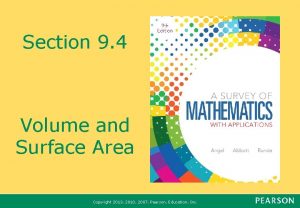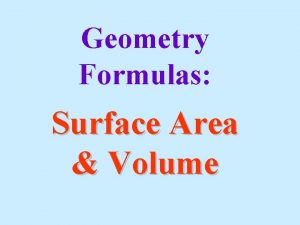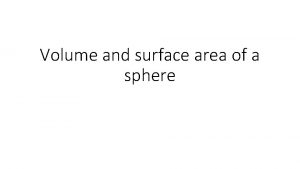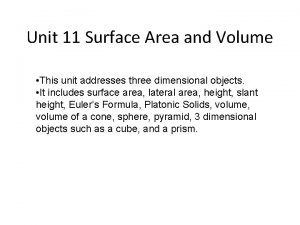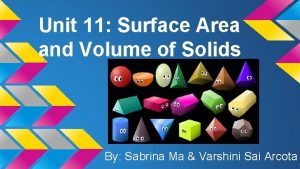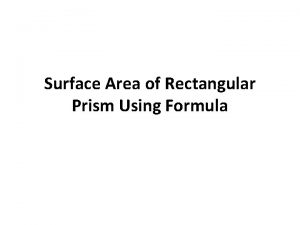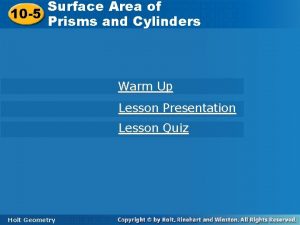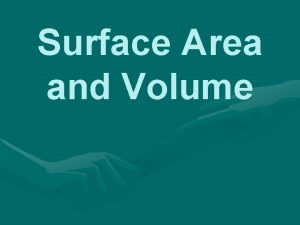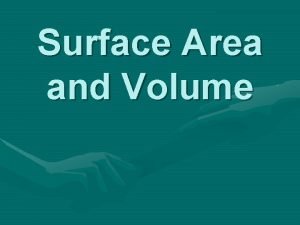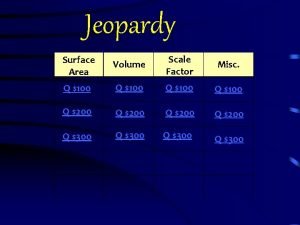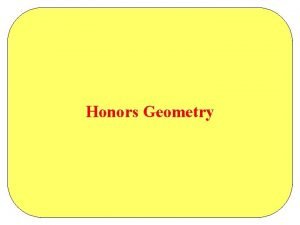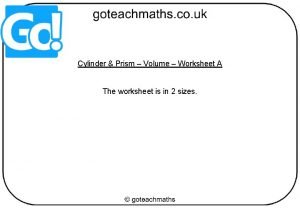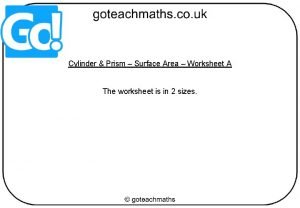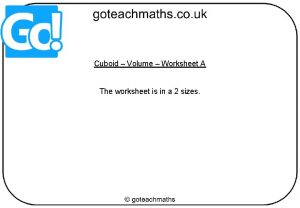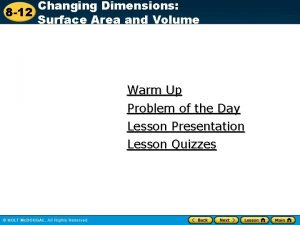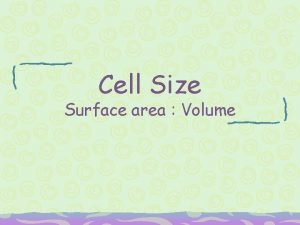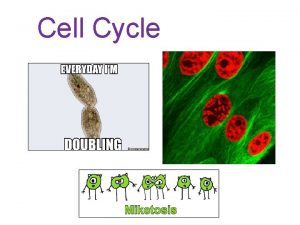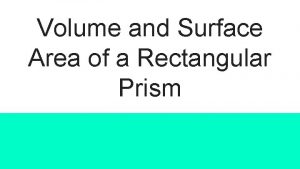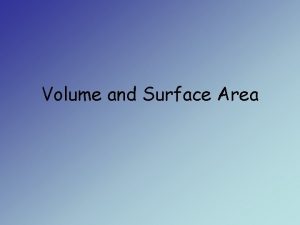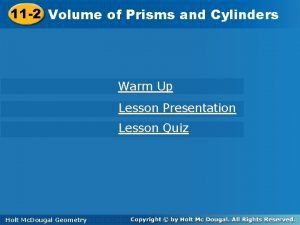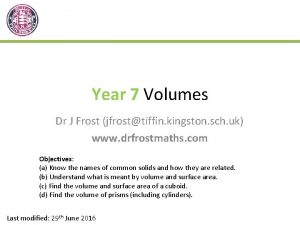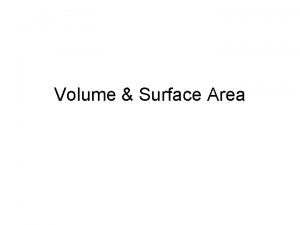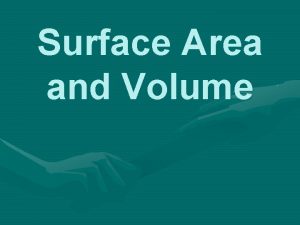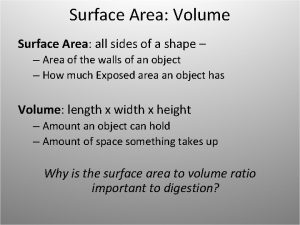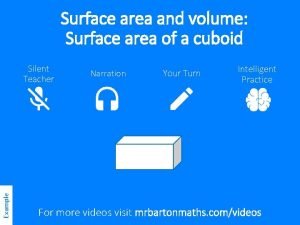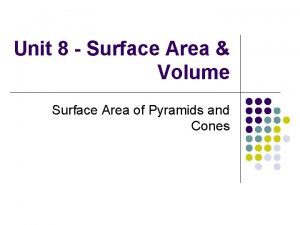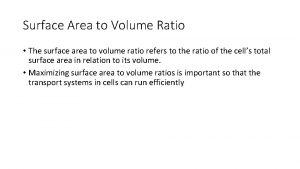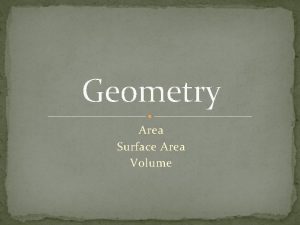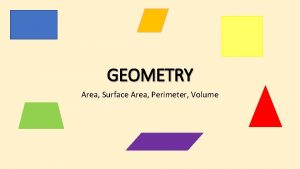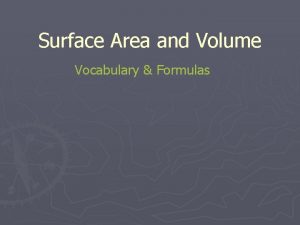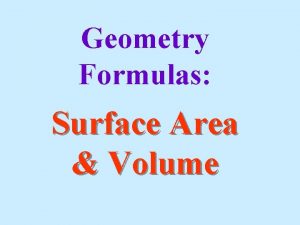FORMULAS Definitions Area PerimeterCircumference Surface Area Volume Distance




























- Slides: 28

FORMULAS

Definitions Area Perimeter/Circumference Surface Area Volume Distance / Rate Simple Interest Density

Distance = Rate x Time How far did you travel if you drove at a rate of 60 miles per hour for 5 hours? D = rt D = 60 x 5 D = 300 Answer: 300 miles

Time = Distance / Rate How much time did it take for you to travel 300 miles at a rate of 60 miles per hour? T = D/r T = 300 / 50 D = 5 Answer: 5 hours

D = rt Find D if r = 12 and t = 8 D = rt D = 12 x 8 D = 96 Find r if D = 240 and t = 8 D = rt 240 = r x 8 Solve backwards 240 / 8 = r 30 = r D = rt 240 = 8 r 8 8 30 = r


Simple Interest I = PRT Interest = Principle x Rate x Time How much interest would you make if you deposited $500 at the bank at a rate of 10% per year for 4 years? I = 500 x. 10 x 4 I = $200

Simple Interest I = PRT Interest = Principle x Rate x Time How much time did you keep your money in the bank if you made $400 in interest at a rate of 5% with an initial deposit of $800 ( principle)? 400 = 800 x. 05 x t 400 = 40 x t 401400 / 40 = 10 years

Simple Interest I = PRT How much time did you keep your money in the bank if you made $400 in interest at a rate of 5% with an initial deposit of $800 ( principle)? I = PRT 400 = 800 x. 05 x t 400 = 40 t 401400 = 402 40 403 10 40 t 40 = t


Circumference of a Circle PI TIMES DIAMETER PI TIMES DOUBLE THE RADIUS 3. 14 d

Circumference of a Circle C = 3. 14 d Find C if d = 10 31. 4 units Find C if d = 5 15. 7 units Find C if r = 5 31. 4 units

Circumference of a Circle C = 3. 14 d Find d if C = 400 20 units Substitute 400 for C C = 3. 14 d Solve backwards 400 = 3. 14 d 3. 14 times what is 400 = 3. 14 d Divide 400 by 3. 14 4013. 14 20 = d

Area of a Circle PI TIMES RADIUS TO SECOND POWER A = 3. 14 r 2 A = 3. 14 x r


Area of a Circle A = 3. 14 r Find A if r = 10 Find A if r = 5 Find A if r = 20 314 2 square units 78. 5 square units 1256 square units

Area of a Circle A = 3. 14 r 2 Find r if A = 2826 sq units 2826 = 3. 14 x r 2 30 units A = 3. 14 r 2 Work backwards 2826= 3. 14 r 2 Undo operations 28272826 Step by step 3. 14 Divide by 3. 14 900 Square Root 901 30 = 3. 14 r 2 3. 14 = r 2 = r


Surface Area of a Rectangular Prism SA is double the area of the front + double the area of the side + double the area of the top SA = 2 lw + 2 lh + 2 wh

SA = 2 lw + 2 lh + 2 wh H = 6 cm W = 5 cm L = 10 cm SA = 280 square centimeters

Surface Area Hint: 6 cm use every combination 5 cm 10 cm SA = 2 lw + 2 lh + 2 wh SA = 2*10*5 + 2*10*6 + 2*5*6 SA = + + 100 120 60 SA = 280 square centimeters

Surface Area

Volume of a Rectangular Prism V = lwh H = 6 inches W = 4 inches L = 25 inches 600 cubic inches

Volume 6 inches 25 inches V = 4 inches lwh V = 25 * 4 * 6 V = 600 cubic inches

Volume of a Rectangular Prism

Density = Mass / Volume Take a look at the two boxes above. Each box has the same volume. If each ball has the same mass, which box would weigh more? Why? The box that has more balls has more mass per unit of volume. This property of matter is called density. The density of a material helps to distinguish it from other materials. Since mass is usually expressed in grams and volume in cubic centimeters, density is expressed in grams/cubic centimeter.

Density = Mass / Volume 6 cm 5 cm 4 cm 1. Calculate Volume: V = lwh V = 120 cc 2. Calculate Mass: 3. Each marble weighs 10 grams Box 1 contains 24 marbles M = 240 g Box 2 contains 12 marbles M = 120 g

Density = Mass / Volume 6 cm 5 cm 4 cm Calculate Density: Volume = 120 cc D = M/V Mass 1 = 250 g D = 240/120 Mass 2 = 130 g D = 120/120 D=2 D=1
 Lateral area of a rectangular prism formula
Lateral area of a rectangular prism formula Wet curved surface area
Wet curved surface area Solid figures formula
Solid figures formula Right prism
Right prism Find the volume of the composite figure
Find the volume of the composite figure Lateral surface
Lateral surface Unit 11 volume and surface area
Unit 11 volume and surface area How to find the surface area of a rectangle
How to find the surface area of a rectangle 10-4 surface area of prisms and cylinders
10-4 surface area of prisms and cylinders Circumference of cylinder
Circumference of cylinder Surface area of cone formula
Surface area of cone formula The volume of pyramid
The volume of pyramid Volume maze
Volume maze Importance of surface area to volume ratio
Importance of surface area to volume ratio Jeopardy surface area and volume
Jeopardy surface area and volume Area perimeter volume jeopardy
Area perimeter volume jeopardy Volume and surface area jeopardy
Volume and surface area jeopardy La=2πrh
La=2πrh Volume of a half cylinder
Volume of a half cylinder Surface area cylinders and prisms worksheet
Surface area cylinders and prisms worksheet Cube and cuboid worksheet
Cube and cuboid worksheet Effects of changing dimensions on surface area and volume
Effects of changing dimensions on surface area and volume Surface area to volume ratio
Surface area to volume ratio Surface area to volume ratio
Surface area to volume ratio Volume and surface area of rectangular prism
Volume and surface area of rectangular prism Volume objectives
Volume objectives The volume of this prism is 378 cm 3
The volume of this prism is 378 cm 3 Quiz 11-2 volume and surface area
Quiz 11-2 volume and surface area Dr frost volume
Dr frost volume


